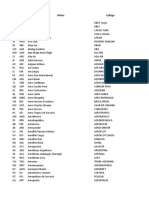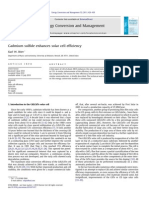1.3b-2
1.3b-2
Uploaded by
remy adrianCopyright:
Available Formats
1.3b-2
1.3b-2
Uploaded by
remy adrianCopyright
Available Formats
Share this document
Did you find this document useful?
Is this content inappropriate?
Copyright:
Available Formats
1.3b-2
1.3b-2
Uploaded by
remy adrianCopyright:
Available Formats
Small Vehicles Powered by Lithium
Batteries – P a ss en g e r
P ro v is ion s
Updated 16 December 2015
Background
This notice is in response to questions raised by operators regarding the acceptability of
small vehicles that are powered by lithium ion batteries in passenger checked and/or carry-
on baggage. There have been reports of these small vehicles being sold at airports in
airside shops, as well as being available in many cities, particularly in Asia.
Some examples of these small lithium battery-powered vehicles are: airwheel, solowheel,
hoverboard, mini-segway, balance wheel.
Discussion took place with a number of the members of the ICAO Dangerous Goods
Panel as to how these devices should be treated for the purposes of the provisions of
Dangerous Goods Carried by Passengers and Crew, DGR Subsection 2.3.
The agreed view is that these devices are not “mobility aids”, but instead be treated as
“portable electronic devices” (PED) on the basis that the item subject to the Regulations is
the lithium ion battery that powers these devices.
The allowance for passengers or crew to have PED in their checked or carry-on baggage
is determined by the size (Watt-hour rating) of the lithium ion battery as follows:
• where the lithium ion battery does not exceed 100 Wh passengers and crew may have
these devices in either checked or carry-on baggage. Approval of the operator is not
required;
• where the lithium ion battery exceeds 100 Wh but does not exceed 160 Wh
passengers and crew may have these devices in either checked or carry-on baggage,
but the approval of the operator is required; and
IATA Cargo Page 1 16 December 2015
• where the lithium ion battery exceeds 160 Wh the device is forbidden from being in
either passenger or crew checked or carry-on baggage.
Recommendations
In areas and cities where these devices are readily available operators should ensure that
passenger handling staff and the ground service provider, where applicable, are made
aware that these devices are subject to the restrictions applicable to PED as set out
above.
Operators should consider developing posters, notices or other material with pictures or
images of these small lithium battery-powered vehicles for display on their websites, at
self-serve kiosks and check-in counters, specifically at airports serving cities where these
devices are available, to alert passengers to the conditions applicable to their carriage in
checked or carry-on baggage.
At these airports, the operators may wish to bring this matter to the attention of the airport
operator’s committee so that a coordinated and consistent message is presented to
passengers. The airport operator’s committee may also wish to coordinate with the airport
operator to ensure that on-airport retailers are made aware of the restrictions that apply to
the carriage of these devices by passengers, and potentially the restriction on sale to
passengers where the operator does not approve the carriage of PED with a lithium ion
battery that exceeds 100 Wh.
It is recommended that operators include the following in their operational manuals, or
instructions to passenger service staff to address the passenger carriage of these small
lithium battery-powered vehicles:
Personnel, including those of ground service providers, must verify that:
• the devices are protected against accidental activation by either being in the original
manufacturer’s packaging or by taping over the on/off switch;
• the Watt-hour rating of the lithium ion battery in the device does not exceed 160 Wh.
All lithium ion batteries are required to have the Watt-hour rating marked on the
outside of the battery case. If passenger handling staff are unable to verify the Watt-
hour rating by checking either the battery, or the user documentation, it is
recommended that the passenger be advised that the device cannot be carried;
Note: The watt-hour rating is calculated by multiplying the voltage (V) by the ampere
hours (Ah). Where the amperage is shown as milliampere hours (mAh) divide the mAh
value by 1,000 to establish the Ah.
If cabin crew identify that the device does not meet the operator's requirement during
boarding, they should refer to the ground personnel for proper offloading.
It is recommended that operators restrict these devices to carry-on baggage.
However, PED as carry-on baggage are subject to specific operator restrictions on the
size and weight of baggage permitted in the cabin.
You can contact the IATA Dangerous Goods Support team if you have questions or
concerns that may not have been addressed in this document at: dangood@iata.org.
IATA Cargo Page 2 16 December 2015
Operator Restrictions
The following operators (airlines) have implemented a total prohibition on the carriage of
balance wheels, hoverboards and other self-balancing vehicles in passenger baggage.
This list is current as at 16 December 2015
Name Code Name Code
Aer Lingus EI Lufthansa LH
Air Astana KC Malaysia Airlines MH
Air Berlin AB Monarch ZB
Air Canada AC Philippine Airlines PR
Air France AF Qantas QF
Air New Zealand NZ Qatar Airways QR
Air Seychelles HM SAS SK
Air Tahiti VT Saudi Arabian Airlines SV
Air Transat TS Singapore Airlines SQ
Alaska Airlines AS South African Airlines SA
All Nippon NH Sri Lankan Airlines UL
American Airlines AA Swiss International LX
Asiana (eff. 21 December) OZ TAM Airlines JJ
Austrian Airlines OS Thai Airways (eff. 21 Dec.) TG
Avianca AV Thomas Cook MT
Bangkok Airways PG Thomson Airways BY
British Airways BA United Airlines UA
Brussels Airlines SN Virgin Australia VA
Cathay Pacific CX
China Airlines CI
Delta Airlines DL
Dragonair KA
Easyjet U2
Emirates EK
Etihad EY
Fiji Airways FJ
Finnair AY
FlyBE BE
Garuda GA
Hong Kong Airlines HX
Japan Airlines JL
Jet Airways 9W
KLM – Royal Dutch Airlines KL
Korean Airlines KE
LAN Airlines LA
IATA Cargo Page 3 16 December 2015
You might also like
- Hodges - The Guild Handbook of Scientific Illustration100% (2)Hodges - The Guild Handbook of Scientific Illustration612 pages
- Airline Codes & Callsigns: Airline Name Call Sign IATA ICAO Numeric100% (1)Airline Codes & Callsigns: Airline Name Call Sign IATA ICAO Numeric25 pages
- Im Acco 01bc Fundamentals of Accounting Part 1100% (1)Im Acco 01bc Fundamentals of Accounting Part 1110 pages
- Planet Rothschild - The Forbidden History of The New World Order (WW2 - 2015)100% (1)Planet Rothschild - The Forbidden History of The New World Order (WW2 - 2015)347 pages
- Certification Packaging Leaflet HGD4 008No ratings yetCertification Packaging Leaflet HGD4 0082 pages
- 342 Partners Available For Ticketing in The United Arab EmiratesNo ratings yet342 Partners Available For Ticketing in The United Arab Emirates2 pages
- 349 Partners Available For Ticketing in ColombiaNo ratings yet349 Partners Available For Ticketing in Colombia2 pages
- Airline Name Airline Name: AS AQ HP AA AP CO DL HA YX NW WN FF TW UA US FLNo ratings yetAirline Name Airline Name: AS AQ HP AA AP CO DL HA YX NW WN FF TW UA US FL1 page
- 124Thatc-Plugin: Atc Plugin For X-Plane 10No ratings yet124Thatc-Plugin: Atc Plugin For X-Plane 10102 pages
- Alliance Members and Low Cost Carriers 79032No ratings yetAlliance Members and Low Cost Carriers 790325 pages
- IATA Airline and Airport or City Codes and TerminologiesNo ratings yetIATA Airline and Airport or City Codes and Terminologies16 pages
- Cadmium Sulfide Enhances Solar Cell EfficiencyNo ratings yetCadmium Sulfide Enhances Solar Cell Efficiency5 pages
- Scope of Work For Mine Plan Preparation - Kuraloi A North Block Final 2No ratings yetScope of Work For Mine Plan Preparation - Kuraloi A North Block Final 25 pages
- Strategi Bisnis Umkm Selama Pandemi Covid-19100% (1)Strategi Bisnis Umkm Selama Pandemi Covid-199 pages
- Chap - 05 - Deck Machinery and Cargo EquipmentNo ratings yetChap - 05 - Deck Machinery and Cargo Equipment31 pages
- Part-1: 1. A Wireless Client Is Attempting To Establish A Connection With A Wireless Access Point. What ProcessNo ratings yetPart-1: 1. A Wireless Client Is Attempting To Establish A Connection With A Wireless Access Point. What Process81 pages
- Renewables Proposal School Board - Jed KurtsNo ratings yetRenewables Proposal School Board - Jed Kurts2 pages
- Evaluation of The Effect of Buccal Corridor Size On Smile AttractivenessNo ratings yetEvaluation of The Effect of Buccal Corridor Size On Smile Attractiveness12 pages
- Mock Drill Calendar 2023-24: Sr. No. Month Type of Mock Drill ROM-50-VIINo ratings yetMock Drill Calendar 2023-24: Sr. No. Month Type of Mock Drill ROM-50-VII4 pages
- Paf Gdp&Cae AD A&SD Test Experiences 28 August 2023No ratings yetPaf Gdp&Cae AD A&SD Test Experiences 28 August 20234 pages
- Class 10 Information Technology Sample Paper Set 5100% (1)Class 10 Information Technology Sample Paper Set 59 pages

























































































